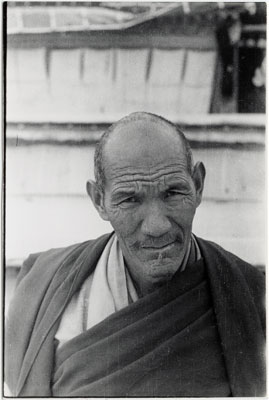
1998.131.375 (Print black & white)


1998.131.375 (Print black & white)

Frederick Spencer Chapman
Frederick Spencer Chapman
December 10th 1936?
Lhasa > Kundeling
1998.131.375
61 x 91 mm
Print gelatin silver
Donated 1994
Faith Spencer Chapman
British Diplomatic Mission to Lhasa 1936-37
Frederick Spencer Chapman
BB.26 In publication
'Lhasa Mission 1936, Diary of Events', P. Neame, H. Richardson, F. S. Chapman, Government of India Political Department [Note: photographs for October 18th - November 4th 1936 are not included as their relationship to text is not detailed; see Mission Diary text for details of images] [see photos in publication]
SC.T.2.375
Notes on print/mount - 'B-B-26' has been written on the back of the print in pencil [MS 22/03/2006]
Manual Catalogues - Caption in Chapman's hand-written list of negatives made whilst on the Mission to Lhasa, 1936-7 [See PRM Manuscripts Collection]: 'Face of ditto [Head of Gundeling]'; PRM Manuscripts Collection: ‘List of Tibetan Prints and Negatives’ - Book 2: ‘23/4 - Abbot of Gundeling monastery’ [MS 22/03/2006]
Other Information - Historical Background: This is most probably not the head abbot of Kundeling but the Kundeling Dzaza (Temba Wangchuk) the chief administrator of the monastery and therefore the landlord of the 1936 British mission to Lhasa. [CH 2003]
Biographical Information - The Kundeling Dzaza , who took care of the estates of Kundeling Monastery and was a leading power in the National Assembly. He was also the landlord for the 1936 Mission as Kundeling monastery owned the Dekyi Lingka. As the holder of the title of “Dzaza” and was allowed to wear a yellow silk robe (similar in pattern to that worn by a shappe in the Tibetan government), under his monastic dress. He is described by Spencer Chapman as a man of “great character” with a firm “but humorous” mouth and bright intelligent eyes. “Though he has never in his life been more than thirty miles from Lhasa, he showed a lively interest in many subjects. He asked us, for instance, if motor-cars had entirely superseded horses in England as a means of transport; and the relative times it would take to get from Calcutta to London be air, by steamer, and on foot.” ['Lhasa: The Holy City', F. Spencer Chapman, London: Chatto & Windus, 1938, pp. 204-205] [MS 22/03/2006]
Other Information - Related Images: Images prefixed with 'BB' comprise a group of negatives containing images of street scenes, the new depon at Gyantse, two monks with long trumpets, mummers, Pendong, Kalon lama, the head of Kundeling, ‘disease chasing ceremony’ and Chinese statues in Kundeling monastery. The images in and around Kundeling seem to have been taken on December 10th at the 'Disease Chasing Ceremony' [MS 22/03/2006]
Other Information - Background: Richardson mentions Kundeling monastery in High Peaks, Pure Earth , London, Serindia Publications, 1998, p. 303. "The monastery of Kun-bde-gling (1936-9, 1944, 1946-50) was built by the Chinese in 1794 for their protege,the Regent Rta-tshag Ye-shes mgon-po, in celebration of their victory over the Gurkhas. It was very generously endowed. A stone stele recording the foundation, inscribed in Tibetan and Chinese, stood at the entrance of the monastery. Further north on a rocky hillock known as Ba-ma-ri (or Ba-mo-ri) stood a little temple of the Chinese war god Kuanti, known to the Tibetans as Ge-sar. ... The Ge-sar Lha-khang was popular with Tibetan pilgrims for the reading of fortunes from bamboo slips chosen at random from a tall vase." [KC 13/10/2006]
For Citation use:
The Tibet Album.
"Kundeling Dzasa , Temba Wangchuk"
05 Dec. 2006. The Pitt Rivers Museum.
<http://tibet.prm.ox.ac.uk/photo_1998.131.375%0B.html>.
For more information about photographic usage or to order prints, please visit the The Pitt Rivers Museum.
© The Pitt Rivers Museum